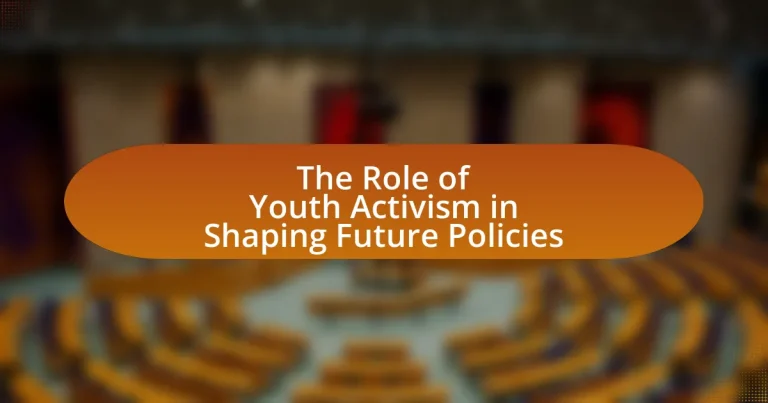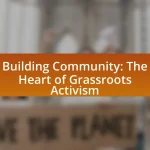Youth activism is a significant force in shaping future policies, as it mobilizes young individuals to advocate for social, environmental, and political change. The article explores the historical influence of youth activism on policy changes, highlighting key movements such as the Civil Rights Movement, March for Our Lives, and climate strikes led by figures like Greta Thunberg. It discusses the unique perspectives young activists bring to policy discussions, the challenges they face, and the strategies they employ to engage their peers and mobilize for change. Additionally, the article examines the role of educational institutions and partnerships in supporting youth activism, as well as the future implications of these movements on policy-making.
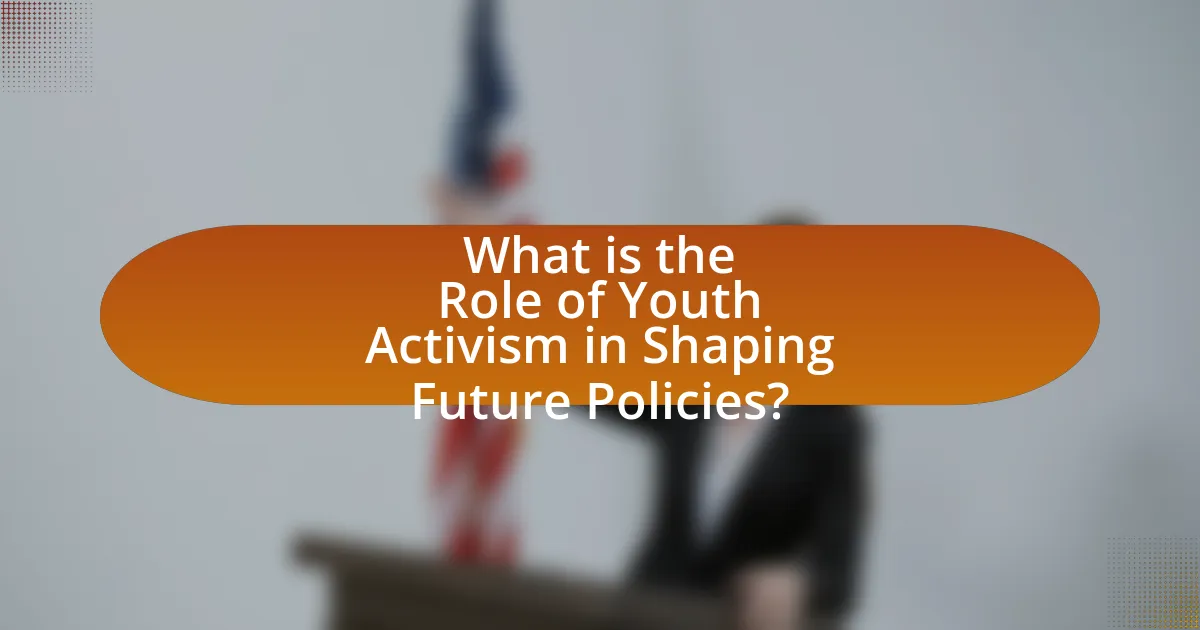
What is the Role of Youth Activism in Shaping Future Policies?
Youth activism plays a crucial role in shaping future policies by mobilizing young people to advocate for social, environmental, and political change. This demographic often brings fresh perspectives and innovative solutions to pressing issues, influencing decision-makers and public opinion. For instance, movements like Fridays for Future, initiated by Greta Thunberg, have significantly impacted climate policy discussions globally, leading to increased commitments from governments to reduce carbon emissions. Additionally, studies show that youth-led initiatives can drive legislative changes, as seen in the U.S. with the March for Our Lives movement advocating for gun control, which has resulted in new laws in several states. Thus, youth activism not only raises awareness but also directly contributes to the formulation and implementation of policies that reflect the values and needs of younger generations.
How has youth activism historically influenced policy changes?
Youth activism has historically influenced policy changes by mobilizing young people to advocate for social, political, and environmental reforms. For instance, the Civil Rights Movement in the 1960s saw significant youth involvement, with students organizing protests and sit-ins that pressured lawmakers to enact the Civil Rights Act of 1964. Similarly, the anti-Vietnam War protests led by youth in the late 1960s contributed to a shift in public opinion and ultimately influenced U.S. foreign policy. Additionally, the climate strikes initiated by youth activists like Greta Thunberg have prompted governments worldwide to reconsider their environmental policies, demonstrating the ongoing impact of youth activism on legislative change.
What key movements exemplify the impact of youth activism on policy?
Key movements that exemplify the impact of youth activism on policy include the March for Our Lives, which emerged after the Parkland school shooting in 2018, advocating for gun control legislation. This movement successfully influenced lawmakers and led to the introduction of various gun safety bills across multiple states. Another significant movement is the climate strikes initiated by Greta Thunberg, which mobilized millions of young people globally and pressured governments to commit to more aggressive climate action, resulting in policy changes in several countries. Additionally, the Black Lives Matter movement, particularly its resurgence in 2020, has led to policy discussions around police reform and racial justice, demonstrating the power of youth-led activism in shaping legislative agendas.
How do historical examples inform current youth activism strategies?
Historical examples inform current youth activism strategies by providing proven frameworks and tactics that enhance effectiveness. For instance, the civil rights movement of the 1960s demonstrated the power of organized protests and grassroots mobilization, which contemporary youth activists, such as those involved in the Black Lives Matter movement, have adopted to address systemic racism. Additionally, the anti-apartheid movement in South Africa showcased the impact of international solidarity and advocacy, influencing today’s youth to leverage social media for global awareness and support. These historical precedents illustrate how strategic planning, coalition-building, and the use of technology can amplify youth voices and drive policy change.
Why is youth activism important in contemporary society?
Youth activism is important in contemporary society because it empowers young individuals to influence social and political change. This demographic often brings fresh perspectives and innovative solutions to pressing issues such as climate change, racial equality, and education reform. For instance, the global climate strikes led by youth activists like Greta Thunberg have mobilized millions and raised awareness about environmental issues, demonstrating the significant impact youth can have on public discourse and policy-making. Furthermore, studies show that youth engagement in activism fosters civic responsibility and encourages lifelong participation in democratic processes, thereby shaping future policies that reflect the values and needs of younger generations.
What unique perspectives do young activists bring to policy discussions?
Young activists bring fresh, innovative perspectives to policy discussions by emphasizing the urgency of addressing issues like climate change, social justice, and equity. Their unique viewpoints often stem from a deep understanding of the challenges faced by their generation, which is shaped by contemporary social media engagement and grassroots organizing. For instance, studies show that youth-led movements, such as the global climate strikes initiated by Greta Thunberg, have successfully shifted public discourse and influenced policy agendas, demonstrating the effectiveness of youth activism in advocating for systemic change. This generational insight allows young activists to challenge traditional approaches and propose solutions that resonate with a broader, more diverse audience.
How does youth activism address issues that affect younger generations?
Youth activism addresses issues affecting younger generations by mobilizing collective action to advocate for policy changes and raise awareness on critical topics such as climate change, education reform, and social justice. For instance, movements like Fridays for Future, initiated by Greta Thunberg, have galvanized millions of young people worldwide to demand urgent action on climate policies, highlighting the direct impact of environmental degradation on their futures. Additionally, youth-led organizations often utilize social media platforms to amplify their messages, engage peers, and influence public opinion, thereby creating a significant pressure on policymakers to consider the perspectives and needs of younger demographics. This approach not only empowers youth voices but also fosters a sense of agency among young activists, reinforcing their role in shaping policies that directly affect their lives.
What challenges do youth activists face in shaping policies?
Youth activists face significant challenges in shaping policies, primarily due to systemic barriers, lack of access to decision-making processes, and limited resources. Systemic barriers include age-related biases that often lead to the dismissal of their perspectives by older policymakers. Additionally, youth activists frequently encounter difficulties in gaining access to platforms where policy discussions occur, as these spaces are often dominated by established political figures. Limited financial and organizational resources further hinder their ability to mobilize effectively and sustain campaigns. According to a 2021 report by the United Nations, youth representation in political processes remains disproportionately low, highlighting the ongoing struggle for meaningful engagement in policy-making.
How do societal perceptions of youth impact their activism efforts?
Societal perceptions of youth significantly influence their activism efforts by shaping the credibility and visibility of their voices. When society views young people as capable and informed, it enhances their ability to mobilize support and engage in meaningful dialogue, as seen in movements like the March for Our Lives, which gained traction due to positive media coverage and public support for youth-led initiatives. Conversely, negative perceptions, such as viewing youth as inexperienced or apathetic, can undermine their activism by limiting opportunities for engagement and dismissing their contributions. Research indicates that youth activism is often more effective in environments where societal attitudes are supportive, as demonstrated by the increased participation rates in countries that encourage youth involvement in political processes.
What barriers exist in political systems that hinder youth activism?
Barriers in political systems that hinder youth activism include lack of representation, restrictive laws, and limited access to resources. Youth often find themselves underrepresented in decision-making processes, which diminishes their influence on policies that affect them. Additionally, laws that restrict assembly and protest can stifle youth voices, as seen in various countries where youth-led movements face legal challenges. Furthermore, limited access to funding and organizational support can hinder the ability of youth activists to mobilize effectively, as evidenced by studies showing that financial constraints are a significant obstacle for grassroots movements.
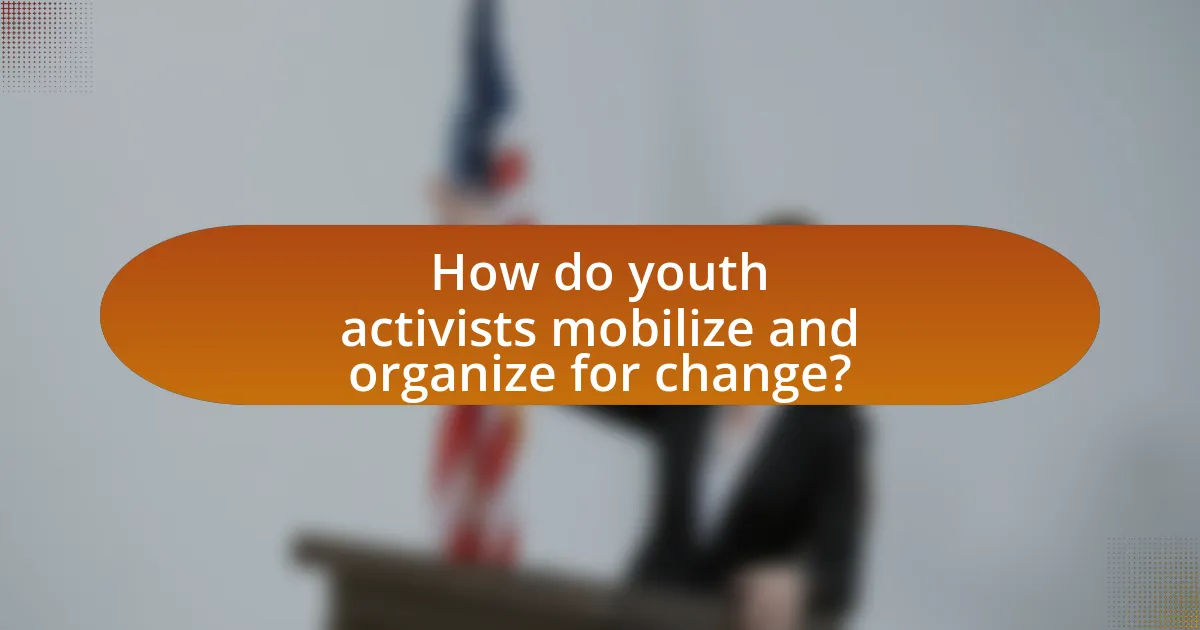
How do youth activists mobilize and organize for change?
Youth activists mobilize and organize for change through strategic use of social media, grassroots campaigns, and community engagement. By leveraging platforms like Instagram and Twitter, they disseminate information rapidly, build networks, and raise awareness about social issues. For instance, the global climate strikes initiated by youth activists in 2019, inspired by Greta Thunberg, showcased how coordinated online efforts can lead to mass participation in protests, influencing public discourse and policy discussions. Additionally, youth organizations often collaborate with established NGOs to amplify their impact, as seen in movements like Black Lives Matter, where young leaders played crucial roles in organizing protests and advocating for policy reforms. These methods demonstrate the effectiveness of youth activism in driving societal change.
What strategies do youth activists use to engage their peers?
Youth activists engage their peers through social media campaigns, grassroots organizing, and educational workshops. Social media platforms like Instagram and TikTok allow activists to share compelling narratives and visuals that resonate with young audiences, fostering a sense of community and urgency around issues such as climate change and social justice. Grassroots organizing involves mobilizing local communities through events and demonstrations, which not only raises awareness but also encourages participation in collective action. Educational workshops provide a space for peer-to-peer learning, equipping young people with the knowledge and skills necessary to advocate for change effectively. These strategies have been shown to increase engagement and participation among youth, as evidenced by the rise in youth-led movements like Fridays for Future, which successfully mobilized millions globally for climate action.
How do social media platforms enhance youth activism efforts?
Social media platforms enhance youth activism efforts by providing accessible communication channels that facilitate organization, mobilization, and awareness-raising. These platforms allow young activists to share information rapidly, connect with like-minded individuals, and amplify their messages to a broader audience. For instance, the use of hashtags on platforms like Twitter and Instagram has been instrumental in organizing movements such as #BlackLivesMatter, which gained significant traction and visibility, leading to increased public discourse and policy discussions. Additionally, a study by the Pew Research Center found that 69% of teens use social media to express their views on social and political issues, demonstrating the platforms’ effectiveness in engaging youth in activism.
What role do educational institutions play in supporting youth activism?
Educational institutions play a crucial role in supporting youth activism by providing platforms for engagement, fostering critical thinking, and encouraging civic participation. These institutions often facilitate discussions on social issues, enabling students to explore activism through coursework, clubs, and events. For instance, many universities have student-led organizations that advocate for various causes, empowering students to take action and influence policy. Research indicates that students involved in activism during their educational years are more likely to remain engaged citizens later in life, as highlighted in the study “Youth Activism: A New Generation of Leaders” by the Harvard Kennedy School, which emphasizes the long-term impact of educational support on civic engagement.
How do coalitions and partnerships strengthen youth activism?
Coalitions and partnerships strengthen youth activism by enhancing resource sharing, amplifying voices, and increasing collective impact. When youth organizations collaborate, they pool financial, human, and informational resources, which allows for more effective campaigns and initiatives. For example, the collaboration between various youth-led organizations during the March for Our Lives movement in 2018 showcased how partnerships can mobilize thousands of young people to advocate for gun control, demonstrating a significant increase in visibility and influence. Additionally, coalitions provide a platform for diverse perspectives, fostering inclusivity and solidarity among different youth groups, which can lead to more comprehensive and effective advocacy strategies. This collaborative approach not only strengthens the message but also builds a larger support network, making it easier to engage with policymakers and the public.
What types of organizations collaborate with youth activists?
Various types of organizations collaborate with youth activists, including non-governmental organizations (NGOs), educational institutions, community groups, and governmental agencies. NGOs often provide resources, training, and platforms for youth to engage in activism, while educational institutions may support youth-led initiatives through programs and research opportunities. Community groups facilitate local activism and empower youth to address specific issues within their neighborhoods. Governmental agencies may collaborate by involving youth in policy-making processes, recognizing their role in shaping future policies. This collaboration is essential for fostering civic engagement and ensuring that youth voices are heard in decision-making.
How do these partnerships amplify the voices of young activists?
Partnerships amplify the voices of young activists by providing them with platforms, resources, and networks that enhance their visibility and influence. These collaborations often connect young activists with established organizations, media outlets, and policymakers, enabling them to share their messages more broadly. For instance, initiatives like the Youth Climate Summit have successfully showcased young leaders, resulting in increased media coverage and public engagement on climate issues. This visibility is crucial, as studies indicate that youth-led movements can drive significant policy changes, evidenced by the global response to the Fridays for Future movement, which mobilized millions and influenced climate policies worldwide.
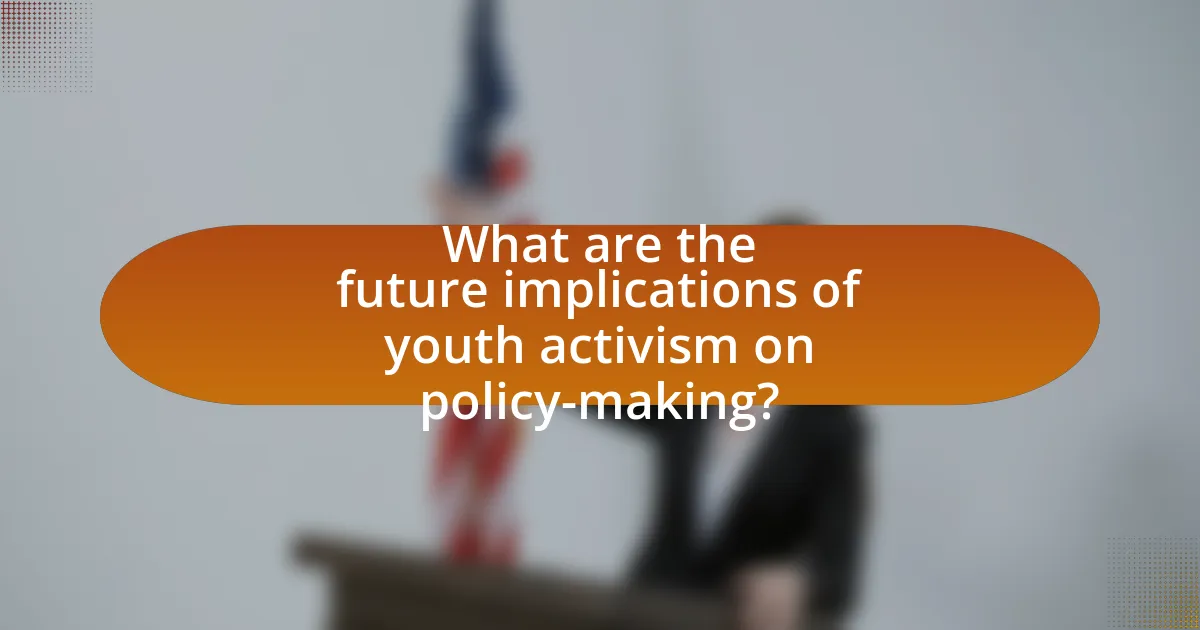
What are the future implications of youth activism on policy-making?
Youth activism will significantly influence future policy-making by driving progressive changes and prioritizing issues such as climate change, social justice, and equity. As young activists increasingly mobilize through social media and grassroots movements, they are reshaping public discourse and pressuring policymakers to respond to their demands. For instance, the global climate strikes led by youth activists like Greta Thunberg have resulted in heightened awareness and legislative discussions around climate policies in various countries. This trend indicates that youth activism not only raises awareness but also compels governments to adopt more responsive and inclusive policies that reflect the values and priorities of younger generations.
How might youth activism evolve in the coming years?
Youth activism is likely to evolve through increased digital engagement and intersectionality in the coming years. As technology advances, young activists will leverage social media platforms to mobilize support, share information, and organize events more efficiently, as evidenced by the success of movements like Black Lives Matter and Fridays for Future, which utilized online tools to amplify their messages globally. Furthermore, the focus on intersectionality will grow, as youth increasingly recognize the interconnectedness of various social issues, leading to more inclusive and diverse coalitions that address climate change, racial justice, and economic inequality simultaneously. This evolution reflects a broader trend of youth becoming more informed and engaged in policy-making processes, as seen in recent youth-led initiatives that have influenced legislation on climate action and social justice.
What emerging issues are likely to drive future youth activism?
Emerging issues likely to drive future youth activism include climate change, social justice, mental health, and digital rights. Climate change remains a critical concern, with youth movements like Fridays for Future mobilizing millions globally to demand action from governments. Social justice issues, including racial equality and gender rights, have gained momentum, as seen in movements such as Black Lives Matter, which highlight systemic inequalities. Mental health awareness is increasingly prioritized, with young people advocating for better resources and support systems. Additionally, digital rights, particularly around privacy and data protection, are becoming significant as youth navigate an increasingly digital world. These issues reflect the values and priorities of younger generations, shaping their activism and influencing policy discussions.
How can youth activists prepare for future policy challenges?
Youth activists can prepare for future policy challenges by developing strong advocacy skills and building coalitions with diverse stakeholders. Engaging in training programs focused on policy analysis, negotiation, and communication enhances their ability to influence decision-making processes. Research indicates that youth-led movements, such as the climate strikes initiated by Greta Thunberg, have effectively mobilized public support and pressured policymakers, demonstrating the impact of organized activism. Additionally, staying informed about current legislative trends and utilizing social media platforms for outreach can amplify their voices and foster community engagement.
What best practices can youth activists adopt to enhance their impact?
Youth activists can enhance their impact by employing strategic communication, building coalitions, and leveraging digital platforms. Strategic communication involves clearly articulating their goals and messages to resonate with diverse audiences, which can increase engagement and support. Building coalitions with other organizations amplifies their reach and resources, as seen in movements like the March for Our Lives, which united various youth groups to advocate for gun control. Leveraging digital platforms allows activists to mobilize quickly and effectively; for example, social media campaigns can reach millions, as demonstrated by the global response to climate change initiatives led by youth activists like Greta Thunberg. These practices collectively strengthen the influence of youth activism in shaping future policies.
How can youth activists effectively communicate their messages?
Youth activists can effectively communicate their messages by utilizing social media platforms to reach a broader audience and engage in real-time discussions. Research indicates that 90% of young people use social media, making it a powerful tool for activism. By creating compelling content, such as videos, infographics, and personal stories, youth activists can resonate emotionally with their audience, thereby increasing awareness and support for their causes. Additionally, collaborating with established organizations can amplify their reach and lend credibility to their messages, as evidenced by successful campaigns like the March for Our Lives, which effectively mobilized youth around gun control issues.
What role does community engagement play in successful activism?
Community engagement is crucial for successful activism as it fosters collective action and amplifies voices within a community. Engaged communities are more likely to mobilize resources, share information, and build networks that enhance the effectiveness of activism efforts. For instance, studies show that grassroots movements, which rely heavily on community involvement, have historically led to significant policy changes, such as the Civil Rights Movement, where local organizations played a pivotal role in mobilizing support and advocating for legislative reforms. This demonstrates that when individuals actively participate in their communities, they create a stronger, unified front that can effectively challenge injustices and influence policy decisions.
